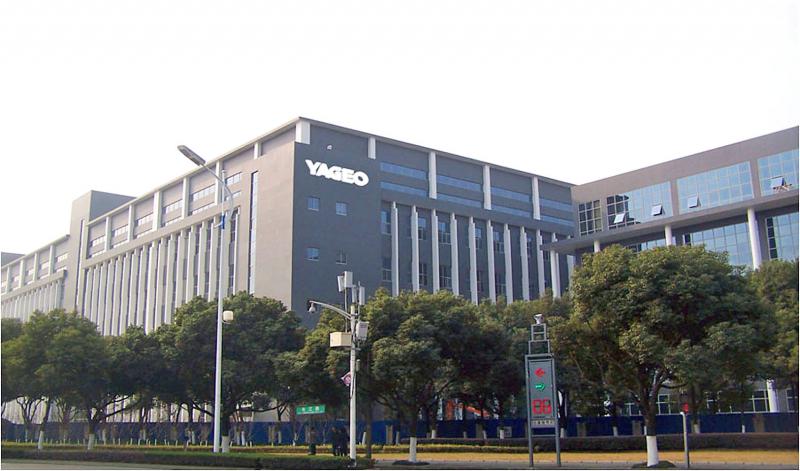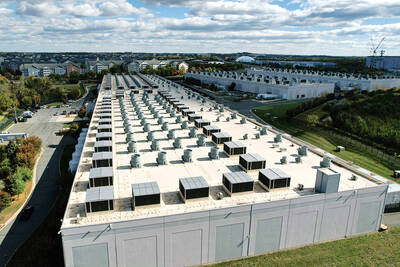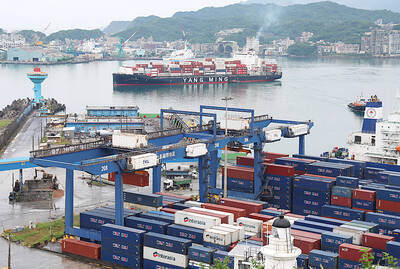Yageo Corp (國巨), a maker of passive components, yesterday reported consolidated revenue of NT$10.53 billion (US$356.78 million) for last month, up 3.8 percent month-on-month and 14.4 percent year-on-year, amid stable demand from major customers and an easing of COVID-19 lockdowns in China’s Kunshan and Shanghai, the company said in a statement.
Yageo’s products include multilayer ceramic capacitors (MLCCs), tantalum capacitors and chip resistors.
It is the world’s third-largest supplier of MLCCs.

Photo: Chang Hui-wen, Taipei Times
Last month’s sales were the highest for May in the company’s history, Yageo data showed.
The company said it remained cautiously optimistic about its sales outlook after Kunshan and Shanghai eased their lockdowns, which had allowed its customers to resume operations and restart shipments.
“Overall, the production and operations of the company’s plants in China remain normal,” Yageo said.
In the first five months of this year, cumulative revenue reached NT$50.8 billion, an annual increase of 21.1 percent, it said.
Separately, Airtac International Group (亞德客), a supplier of pneumatic components, reported consolidated revenue of NT$2.65 billion for last month, up 17 percent from a month earlier, and 18.6 percent from a year earlier as most cities in China gradually relaxed pandemic regulations.
Airtac’s products are used in the production of electronic equipment, general machinery, packaging, automotive devices, batteries, construction equipment and machine tools.
Shipments for the battery, automotive, energy, lighting equipment and electronics industries posted higher growth rates last month, the company said in a regulatory filing.
“As we predicted, the adverse impact of the disease controls on shipments is a short-term phenomenon, and demand has merely been deferred to the coming weeks,” Airtac said. “Current orders are still higher than shipments ... so the company is maintaining its 110 percent utilization rate to increase inventory to meet demand.”
Combined revenue from January to last month grew 7.8 percent year-on-year to NT$11.42 billion, it said.
Meanwhile, BizLink Holding Inc (貿聯控股) on Monday reported that consolidated revenue surged 90.34 percent year-on-year last month to US$157.82 million, the highest monthly sales in the company’s history as customers started to stock up after supply chains gradually returned to pre-lockdown levels.
“Our Kunshan facility [last month] fully resumed normal operations, ramped up production and restarted shipments to customers to catch up on the volume impact from the April lockdown,” Silicon Valley-headquartered BizLink, the sole supplier of wiring harnesses for battery management systems in Tesla Inc’s electric vehicles, said in a statement.
The company’s product portfolio includes components for information technology, consumer electronics and electrical appliances, as well as industrial, automotive, medical, solar and telecom equipment.
Shipments of components used in industrial equipment rose last month due to inventory buildup at its customers, while those for automotive devices and information technology applications showed a steady recovery in shipments, BizLink said.
However, shipments of products used in electrical appliances slowed due to component shortages and longer lead times, while its new German business unit INBG reported weak shipments of telecommunication products for the same reason, BizLink said.
It completed the acquisition of industrial solutions unit INBG from Leoni AG in January, which accounted for 39 percent of its total sales last month, it said.
Combined sales in the first five months increased 89.41 percent year-on-year to US$721.98 million, BizLink said.

The demise of the coal industry left the US’ Appalachian region in tatters, with lost jobs, spoiled water and countless kilometers of abandoned underground mines. Now entrepreneurs are eyeing the rural region with ambitious visions to rebuild its economy by converting old mines into solar power systems and data centers that could help fuel the increasing power demands of the artificial intelligence (AI) boom. One such project is underway by a non-profit team calling itself Energy DELTA (Discovery, Education, Learning and Technology Accelerator) Lab, which is looking to develop energy sources on about 26,305 hectares of old coal land in

Taiwan’s exports soared 56 percent year-on-year to an all-time high of US$64.05 billion last month, propelled by surging global demand for artificial intelligence (AI), high-performance computing and cloud service infrastructure, the Ministry of Finance said yesterday. Department of Statistics Director-General Beatrice Tsai (蔡美娜) called the figure an unexpected upside surprise, citing a wave of technology orders from overseas customers alongside the usual year-end shopping season for technology products. Growth is likely to remain strong this month, she said, projecting a 40 percent to 45 percent expansion on an annual basis. The outperformance could prompt the Directorate-General of Budget, Accounting and

Netflix on Friday faced fierce criticism over its blockbuster deal to acquire Warner Bros Discovery. The streaming giant is already viewed as a pariah in some Hollywood circles, largely due to its reluctance to release content in theaters and its disruption of traditional industry practices. As Netflix emerged as the likely winning bidder for Warner Bros — the studio behind Casablanca, the Harry Potter movies and Friends — Hollywood’s elite launched an aggressive campaign against the acquisition. Titanic director James Cameron called the buyout a “disaster,” while a group of prominent producers are lobbying US Congress to oppose the deal,

Two Chinese chipmakers are attracting strong retail investor demand, buoyed by industry peer Moore Threads Technology Co’s (摩爾線程) stellar debut. The retail portion of MetaX Integrated Circuits (Shanghai) Co’s (上海沐曦) upcoming initial public offering (IPO) was 2,986 times oversubscribed on Friday, according to a filing. Meanwhile, Beijing Onmicro Electronics Co (北京昂瑞微), which makes radio frequency chips, was 2,899 times oversubscribed on Friday, its filing showed. The bids coincided with Moore Threads’ trading debut, which surged 425 percent on Friday after raising 8 billion yuan (US$1.13 billion) on bets that the company could emerge as a viable local competitor to Nvidia